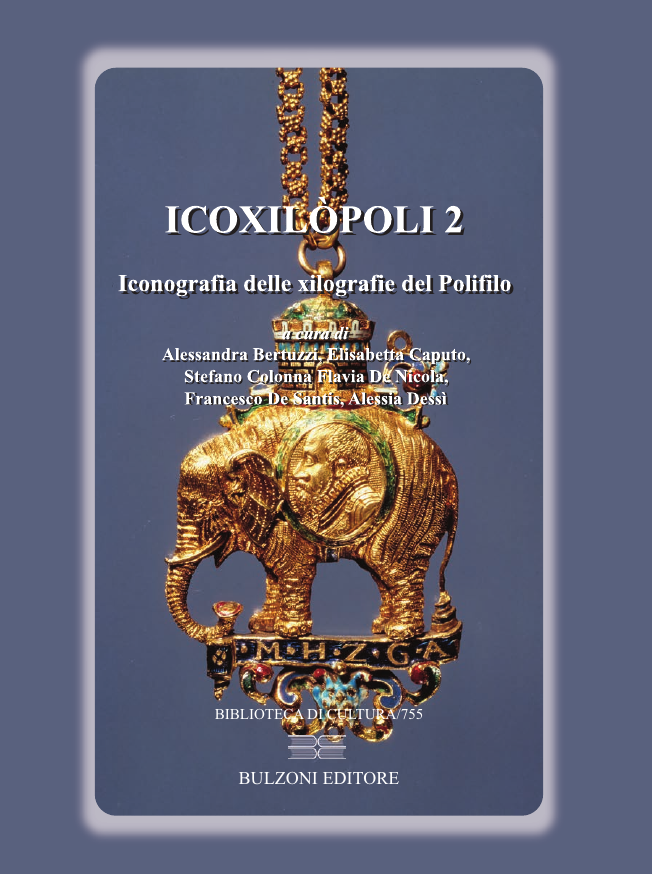
|
Icoxilòpoli 2. Iconografia delle xilografie del Polifilo, Roma, Bulzoni Editore (Collana Biblioteca di Cultura, 755), 2020, a cura di Alessandra Bertuzzi, Elisabetta Caputo, Stefano Colonna, Flavia De Nicola, Francesco De Santis, Alessia Dessì. ISBN 978-88-6897-181-6, pp. 808.
Vai alla pagina del libro presso l'editore
|
|
Abstract en (english translation by Flavia De Nicola revised by Giulia Martina Weston)
In Venice, in 1499, Aldo Manuzio the Elder gave the most important incunabulum of the Italian Renaissance to the press: the Hypnerotomachia Poliphili, accompanied by 171 woodcuts. Over the years, many studies have followed one another to look into the identity of the anonymous author, but only a few of them were dedicated to the 171 images illustrating this printed book, and nowadays the name of the draftsman and that of the engraver remain uncertain. In 2017, the research project Icoxilòpoli 1 - Iconographies of the Polifilo's woodcuts, led by Stefano Colonna in the context of the Museology and Art Criticism and Restoration teaching at the University of Rome La Sapienza, was founded on the ascertainment that specific symbolic themes of the incunabulum are described in the text but not through the images, and vice versa, hence the need to identify the keywords and the symbolic objects both in the text and images, in order to create a two-way path "word-image-word". Icoxilòpoli 2, which takes up Icoxilòpoli 1 subject matters, presents 19 insets relating to Polifilo's woodcuts, ordered by number of appearance in the editio princeps of the Hypnerotomachia dating 1499 and equipped with further analytical essays. The authors well understood the need to continue to operate on an expressive double-track, which could encourage an interpretation of the insets in the key of a "metafictional" story while preserving the academic status of the scientific approach, and this shows how rich Italian academia is in human and scientific potentialities so that, if enhanced, it produces academic results since the first years of research.
Abstract it
Nel 1499, a Venezia, Aldo Manuzio il Vecchio dava alle presse il più importante incunabolo del rinascimento italiano: l'Hypnerotomachia Poliphili, corredato di ben 171 xilografie. Negli anni si sono susseguiti molti studi in merito a chi ne fosse l'anonimo autore, ma solo pochi sono stati dedicati alle 171 immagini che illustrano questo libro stampato, e ancora oggi restano incerti il nome del disegnatore e quello dell'incisore. Nel 2017 nasce il Progetto di ricerca Icoxilòpoli 1 - Iconografie delle xilografie del Polifilo, diretto da Stefano Colonna nel suo Insegnamento di Museologia e Critica Artistica e del restauro della Sapienza, fondato sulla constatazione che determinati argomenti simbolici dell'incunabolo sono descritti nel testo ma non nelle immagini, e viceversa, e quindi sulla necessità di individuare, sia nel testo che nelle immagini, le "parole-chiave" e gli oggetti simbolici, per creare un percorso biunivoco "parola-immagine-parola". Icoxilòpoli 2, che riprende le tematiche di Icoxilòpoli 1, presenta 19 schede relative alle xilografie del Polifilo, ordinate secondo il numero di apparizione nell'editio princeps dell'Hypnerotomachia del 1499 con il corredo di ulteriori saggi analitici. Gli autori hanno ben compreso la necessità di rimanere su un doppio binario espressivo, che favorisse una lettura delle schede in chiave di "meta-romanzo" pur conservando la qualifica accademica dell'approccio scientifico, e ciò dimostra quanto l'università italiana sia ricca di potenzialità umane e scientifiche che, se valorizzate, producono risultati accademici fin dai primi anni di studio.
|